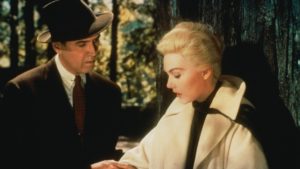Tropic Sprockets / Vertigo (1958)
By Ian Brockway
Alfred Hitchcock’s “Vertigo” is a tour de force. Slick, vivid and gorgeously filmed, it is now noted as one of cinema’s greatest films. [For showtimes and trailer, check Tropiccinema.com.]
From the beginning, the credit-sequence alone by the graphic art genius Saul Bass is a masterpiece in itself. Brilliant and dripping with color, it is years earlier than Pop Art’s Andy Warhol and the dazzling color filtered sequence equals if not surpasses the silver haired silk-screener.
Scottie (Jimmy Stewart) a retired detective suffers from guilt over a fellow cop which makes him terrified of heights. An old friend Elster (Tom Helmore) casually contacts Scottie, asking him for help to track his wife Madeline (Kim Novak) who goes into eerie trances, disappearing for hours. Scottie refuses but feeling guilty somehow, he relents and agrees.
This by itself is strange.
Scottie is hooked by the icy cool Madeline with the arched eyebrows at first sight. Disturbingly, Scottie becomes very much a stalker. He can’t get the opaque phantom like woman out of his head.
This film is probably the most philosophical of Hitchcock’s works. It is also the most quietly disturbing and the most authentic in psychological matters of obsession. Last and certainly not least, it is the most visually beautiful and the most emotive of the director’s films. With its prismatic eye-popping flowers that coalesce around a cool grey women’s suit, the film is a wondrous case study in color theory.
Both clothes and automobiles are made into fetishistic objects of art and desire. The color green speaks of mystery and haunt. The green is the color of Madeline’s car as well as her hotel. Gray is alluring but it also means “Don’t touch me.”
The film boasts a terrific score by the great Bernard Herrmann, who completely encapsulates the story of danger and neurosis within some spectacular cyclic compositions.
Hitchcock’s films entertain and thrill us but here the auteur aims for more dark moodiness than he ever had before. There are no punchlines or maniacs to be found here. In “Vertigo” there is only the push and pull of co-dependence, love and obsession. Everything feels shadowy and full of dreams. There are visual passages where the giant sequoias appear to float or create menace, pre-dating Stanley Kubrick’s mountains in “The Shining.”
This is one Hitchcock film where the pain of love is laid bare.
Creepy it is to see Scottie as a catatonic zombie, his eyes iced gray, and creepier still is it to witness his monstrous behavior in trying to mold Kim Novak into a dream creature solely for his love satisfaction.
Madeline is a tortured feline, but she is also something of an astronaut (her spiral of hair is fixed on her head like a helmet). She is a Gothic walker of dreams with platinum blonde hair. Her dialogue is frequently about death or dreaming.
Psychological and intense, all presented in a Pop Art fashion, “Vertigo” is a genuine cinema experience that demands a big screen.
Hitchcock has never been as bold or as poignant in exploring the magnetism of Love and its darker rhythms.
Write Ian at [email protected]
[livemarket market_name="KONK Life LiveMarket" limit=3 category=“” show_signup=0 show_more=0]

No Comment